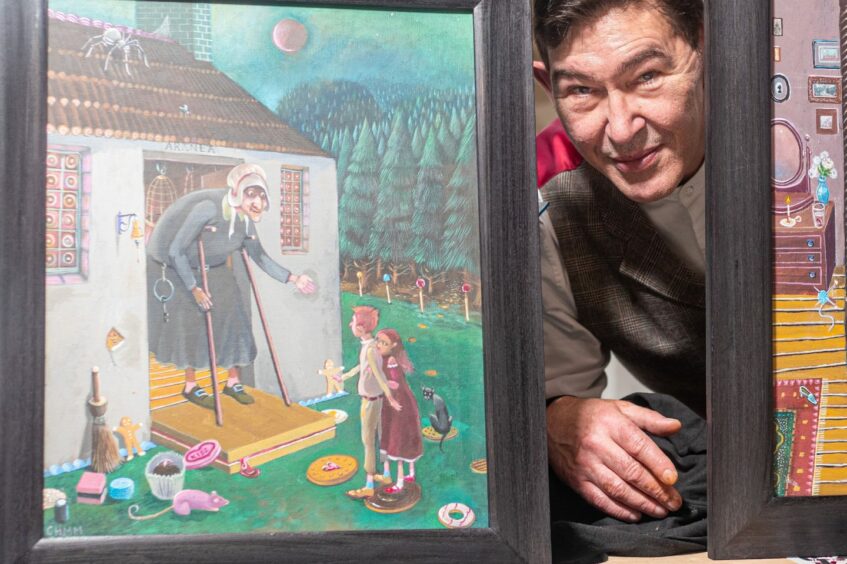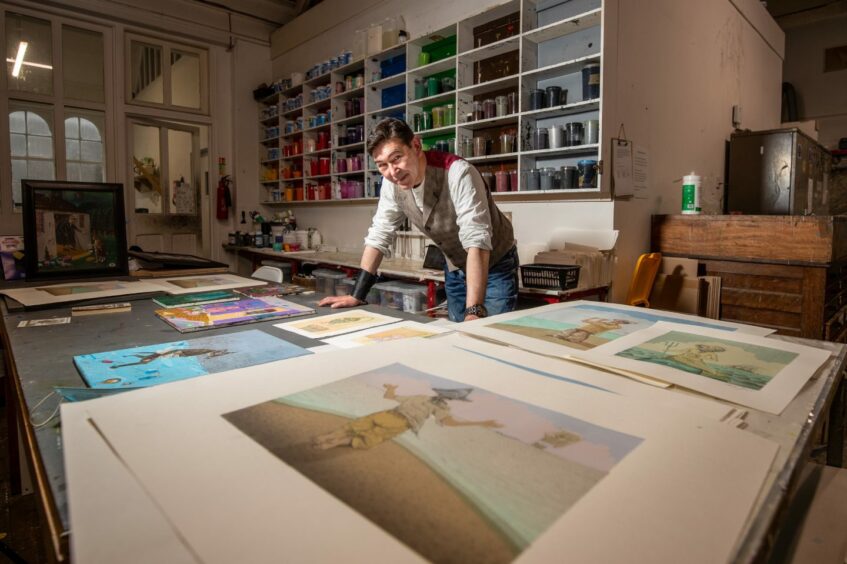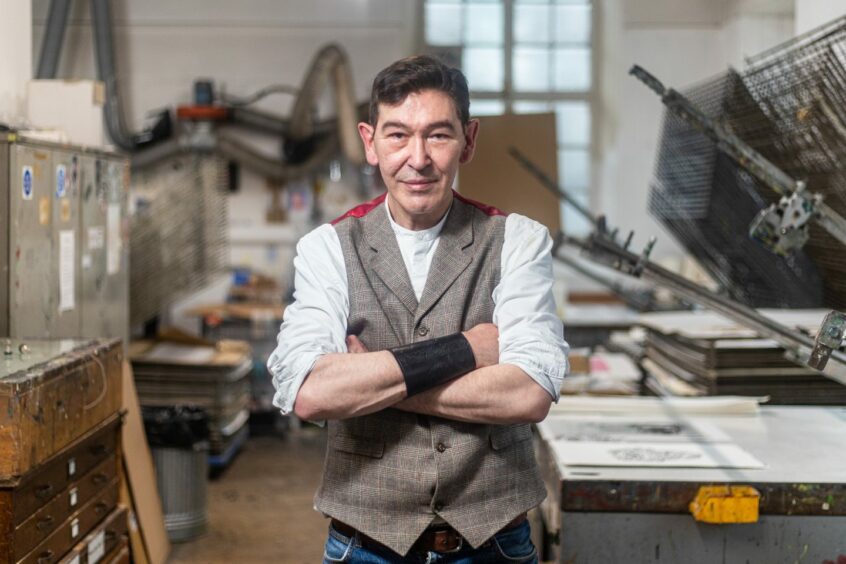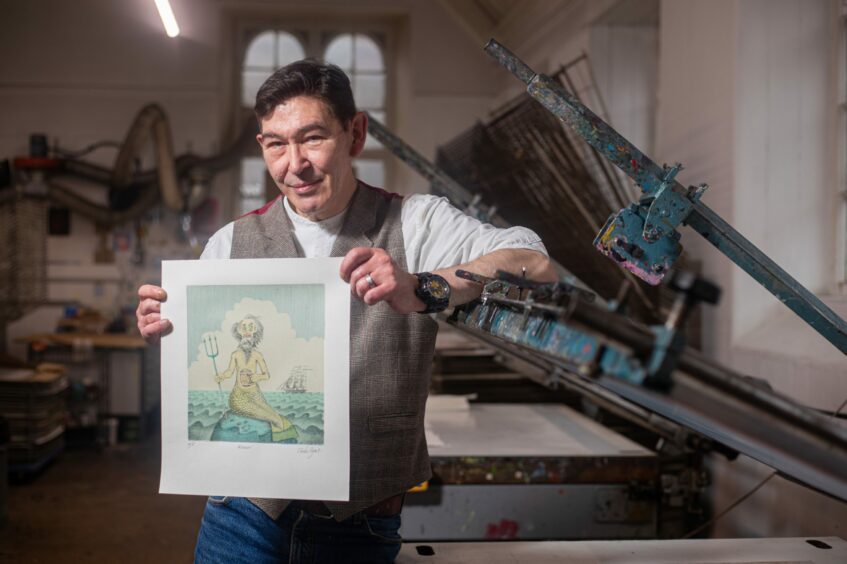It has been a long and winding road since Charlie Hynes first launched his artistic career in the early days of Beatlemania.
Born at Uphall railway station in West Lothian, the youngster was initially encouraged by his grandfather, George Murphy, to draw with chalk on roof tiles and soon became spellbound by the process of bringing pictures to life.
There was little money in the family coffers and Charlie ended up working at the Coop in Pumpherston, the same mining community where his mother regularly served up suppers for hungry customers at the local chip shop.
But ever since he bumped into a “wise and wonderful” old teacher, Hugh Tuckerman, who persuaded him to return to St Mary’s in Bathgate for covert art lessons, this innovative character has been transforming oil and water into gold or whisky through a diverse range of commissions.
He has lived in Aberdeen for many years and spent more than a decade as a printmaker at Peacock Visual Arts in the city, where we met him in typically ebullient fashion as he talked about his past, present and future plans.
Charlie was only five when he collected first prize in a national UK school award for painting and, even as he marvelled at the giant shale bings which surrounded him – “I felt like I was on Mars and it was exciting” – he began exhibiting the gifts which would subsequently bring him to the attention of the Royal Scottish Academy and earn him numerous honours.
At the outset, he never had any illusions he would waltz into a university or art college, let alone benefit from a grant or a bursary, but he possessed the commitment and unstinting work ethic needed to keep developing his repertoire and establish a substantial portfolio.
It meant there was no overnight success, but gradually, inexorably, he made the switch from warehouse worker at a self-service store in Pumpherston to becoming a respected artist for major whisky brands and an illustrator for several authors, including the “Queen of Doric”, Sheena Blackhall.
He told me: “The seeds were first sewn by my grandfather and I just loved every aspect of art, which helped me in the classroom and beyond.
“At secondary school, I gained an A in Higher Art, but I left at 16 to work in the Krazy Kuts warehouse, unloading lorries and getting stuck in at the shop.
“I was still just a working-class teenager in the early 1970s and I had no grand plans, but when Hugh suggested to my mum that I should come back to school, I soon realised it was the best thing I could ever have done.
Sometimes you are left speechless, but people love their drams.”
Charlie Hynes
“I didn’t have the necessary qualifications, but eventually, with Hugh’s invaluable help, my portfolio was accepted by Gray’s School of Art, and that led to me moving to the north-east where I have lived ever since.
“It has been fascinating to work in different mediums and I exhibited my first sculpture at the RSA – a box construction of Moby Dick – and, once again, although I didn’t consider myself a sculptor, it took first prize.
“Hugh was integral to my early success – he was an intuitive man, a gem of a man who taught me to be myself and always trust my instincts.
The glittering prize…
“I suppose, these days, I am a bit of a dinosaur (in not relying on computers and online gadgetry) but I like experimenting with different materials and sometimes you can create a new or unusual impact with surprising things.
“For instance, in depicting the ripples and shifting patterns of the sea, I mixed iridescent ink together with kids’ glitter and it had the desired effect.
“That urge to experiment means there are always surprises to be found in the studio.
“And my wife (Maria Antoinette Morales Hynes) is my shining light and she always encourages me and supports me in my art.”
There is no more compelling example of how Charlie is moving in different circles from when he began his career in West Lothian than his work with Glenfarclas, with whom he collaborated on their 40 Year Old Scottish Classic, which the company described as “a celebration of the third millennium”.
These distinctive bottles of Scotland’s national drink were issued in a limited edition at the start of 2000, but even now some of the items end up in various auction rooms and one sold for £7,500 in London this month.
The range of 600 individually numbered bottles commemorates a triumvirate of great Scottish literary heroes, Sir Walter Scott, Robert Louis Stevenson and Robert “Rabbie” Burns, who have been honoured in a series of artworks produced by three different artists.
Scotch and wry at this price!
Charlie said: “I was commissioned to pay tribute to Stevenson’s books, Treasure Island and Kidnapped, and it was a terrific experience to capture some of the most famous scenes from these famous novels.
“There is an incredible passion for these limited-edition bottles, especially when they are individually numbered, and it does sometimes surprise me when I hear what some collectors are prepared to pay for them.
I’m happy to help anybody who might want any advice.”
Charlie Hynes
“But then, I remember talking to somebody who worked at a luxury hotel in Scotland and they told me that a nip of the stuff was on sale at a cost… of £500.
“Sometimes you are left speechless but people love their drams.”
Charlie is always striving to enter new territory, provide himself with fresh challenges, and he has devised printworks of a character called Merman – which has nothing to do with the old American singer but is a striking marine creature that has elicited an approving reaction at Peacock Visual Arts.
He is in his element in this environment, and there’s a sparkle in his eyes as he recalls the lessons which served him so well all those years ago in such down-to-earth towns as Broxburn, Pumpherston and Bathgate.
As somebody who flourished thanks to the advice and assistance of a mentor, Charlie is keen to encourage youngsters in the north east to pursue their own ambitions, even if they believe that art school or university isn’t for them.
He said: “I saw so many people with talent who didn’t get the chance to go to college that it taught me you have to keep working at your own portfolio and demonstrate your ability in as many different fields as possible.
“Everybody needs to be encouraged and given a step up at the start of their careers and I’m constantly delighted at the standard of art which is being produced not just here in Aberdeen, but across Scotland.
“I’m happy to help anybody who might want any advice.
“Who knows what might have happened to me without Hugh Tuckerman all those years ago?”
Charlie admits that he struggled to understand the Doric dialect when he first arrived in the Granite City.
But in the intervening years, he has revelled in all manner of projects from Union Street 2000 to Blackhall’s collection of poems, Heilanman’s Sporran.
And who knows what he might brew up in the years ahead?





